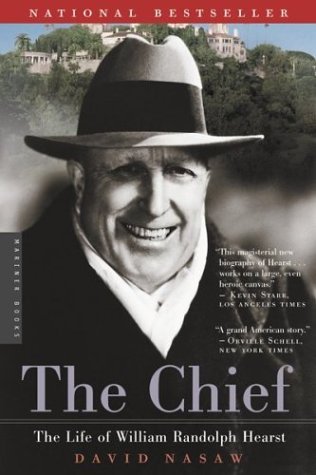 The Chief: The Life of William Randolph Hearst
The Chief: The Life of William Randolph Hearst
by David Nasaw
704 pages
Houghton Mifflin
Published: June 2000
Although more recent biographies of Hearst are now available, David Nasaw’s “The Chief: The Life of William Randolph Hearst” remains the standard biography of this idiosyncratic media tycoon. Nasaw is a biographer and Professor of History at City University of New York. His most popular books are biographies of Joseph P. Kennedy (which I liked) and Andrew Carnegie (which I loved).
William Randolph Hearst (1863-1951) is a remarkably fascinating, but often infuriating, biographical subject. He was born with a silver spoon nearby…if not quite in his mouth. But he learned the art of hard work and perseverance from his father – a self-made mining millionaire. Handed a golden goose (the San Francisco Examiner) at the age of twenty-four, he built an enormous media empire which survives to this day.
Hearst also served as a congressman and unsuccessfully ran for President of the United States, Mayor of New York City (twice) and Governor of New York. Although he was married for nearly fifty years, Hearst enjoyed life with a “domestic partner” for more than thirty years. And his Hearst Castle is a uniquely eclectic and popular West-Coast tourist destination.
Nasaw tackles this imposing media mogul skillfully, leaning on previously unavailable sources including many of Hearst’s personal and business papers. The book’s narrative spans just over six-hundred pages and dispassionately dissects Hearst’s personal and professional lives with appropriate depth if not with consistently tantalizing texture.
Particularly well-described are Hearst’s relationship with his absentee father and ever-present (meddlesome) mother, his fiscal profligacy, his relationships with his wife Millicent and paramour Marion, and the difficulties he encountered building his home near San Simeon. In addition, while some biographers might analyze Hearst’s empire in a way only an accountant could love, Nasaw is thoughtfully parsimonious with the detail he provides.
But for all its merits, this biography exhibits some clear shortcomings. Hearst’s life and travels are ideally suited to dramatic literary scene-setting. And a biographer could provide unparalleled access to the world of muckraking journalism, New York politics and the breathlessly beautiful California vistas. But readers will find the narrative significantly less “colorful” than it could have been; all-too-frequently it exudes an impassive facts-only feel.
In addition, while the construction of Hearst’s California mansion is nicely described, anyone who has visited this impressive home will wish that Nasaw had more fully described its remarkable layout and design. And readers familiar with Citizen Kane are likely to wish Nasaw had dived far more deeply into the similarities and differences between Orson Welles’s character and Hearst himself.
Overall, though, David Nasaw’s “The Chief: The Life of William Randolph Hearst” is a well written and thoroughly researched biography of this renowned media mogul. While not quite as absorbing as Nasaw’s biography of steel magnate Andrew Carnegie, “The Chief” is unmistakably rewarding and seems likely to remain the definitive biography of Hearst for the foreseeable future.
Overall rating: 4 stars
Note: Readers interested in biographies of Hearst are also able to turn to Kenneth Whyte’s 2008 biography “The Uncrowned King: The Sensational Rise of William Randolph Hearst” and Ben Procter’s two-volumes series published between 1998 and 2007 (“William Randolph Hearst: The Early Years, 1863-1910” and “William Randolph Hearst: The Later Years, 1911-1951“). None of these biographies seem particularly beloved, however.
Intrepid readers may be interested to know that Hearst’s long-time mistress Marion Davies wrote “The Times We Had: Life with William Randolph Hearst.” These memoirs were published in 1975, though Davies died in 1961. They have the reputation for being somewhat shallow.
